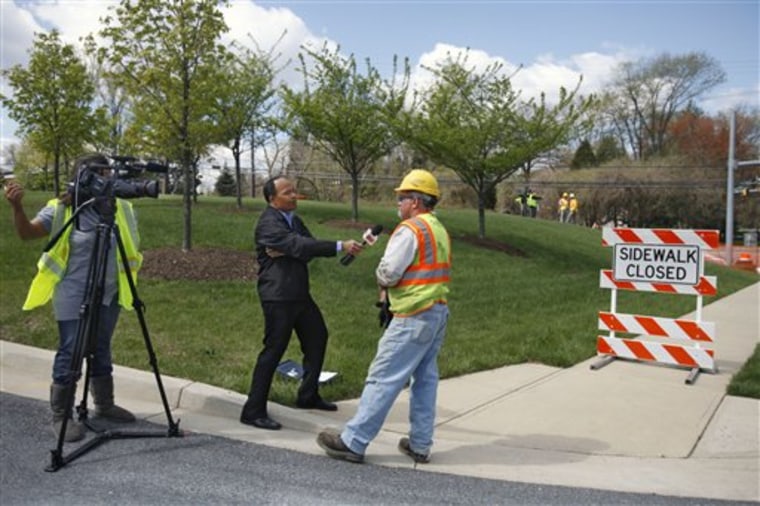When Ed Pegler was laid off from his highway construction job four months ago, the 47-year-old father of two didn't know when he'd be back to work. Then the phone rang. There was a job, paid for by the federal stimulus law.
It's a story the White House hopes to repeat 3.5 million times, to prove that the historic $787 billion spending plan is creating jobs and putting Americans back to work.
But it's not the whole story.
Pegler, of Lancaster, Pa., gets laid off every winter, once it gets too cold to lay asphalt. Every spring, he gets hired back. That's the way it goes in his business. Did the stimulus create his job this year? Did it save a job he already had?
Despite setting a high bar for success and requiring states to report every job created, the White House is still figuring out how to answer those questions. It expects to announce its formula for job-counting soon and, until then, it has cautioned against trumpeting numbers.
That hasn't stopped contractors, governors and even President Barack Obama himself from doing just that.
"This project will start this summer, creating an estimated 900 jobs right away," Obama said earlier this month, describing a Michigan construction project.
"Over 2,500 jobs will be created on Missouri's largest wind farm," he said Wednesday.
The announcements are coming faster than the jobs can be created, much less counted. Though the stimulus is moving projects through the pipeline unusually quickly, only a handful of the roughly 6,000 transportation projects announced nationwide are under contract. Even fewer have broken ground.
But with so much riding on the success of the stimulus bill, the celebration isn't waiting.
When Pegler and his co-workers began repairing sidewalks last week in a Washington suburb, they were interviewed by reporters from as far away as Japan. Maryland says the $2.1 million project will support 60 jobs. A company spokeswoman distributed information at the job site and a transportation industry group handed out its media guide.
"If it wasn't for some of the stimulus money, we wouldn't be calling these people back to work," said Shawn Casey, 33, of Bel Air, Md., manager for the sidewalk project.
For economists, it's far too early to discuss job creation, said University of Chicago economics professor Steven J. Davis, the author of a book and several studies on the subject. Meaningful data won't be available for years, he said.
Compounding the problem, Davis said, is that Obama has invented a new standard to measure success: Jobs saved.
Measuring job creation is complicated but possible. Counting jobs saved by the stimulus is, if not impossible, murky.
"How do you know what a saved job is? How do you know what jobs would have been lost without this?" Davis said. "That was a clever political gimmick to make it even harder to determine whether this policy has any effect."
So far, the definitions the White House budget office has offered are circular: "Jobs created" means new jobs created or filled because of the stimulus. "Jobs retained" means existing jobs retained because of the stimulus.
Most of the numbers being tossed around, including the 900 figure Obama cited, come from a transportation formula estimating the number of jobs "supported" by government spending. It doesn't count new or saved jobs, and the Transportation Department has cautioned against applying the formula to the stimulus.
That doesn't resolve whether Pegler's job was "created." And if his company bids on another project later, will his job be created twice? States have responded to the rules with confusion, and Washington has promised a clarification within the next few weeks.
Elizabeth Oxhorn, a spokeswoman for Vice President Joe Biden, said the clarification will meet "the highest analytical standards."
"We take this responsibility of counting jobs very seriously," she said. "But ultimately our first priority will always be creating them."
Even organizations that stand to benefit from the stimulus say the jobs picture is cloudy.
"There will never be a way of counting the particular jobs that were created or saved or supported by the stimulus," said Bill Buechner, the top economist at the American Road & Transportation Builders Association. He said counting saved jobs requires making "a rough guesstimate of what the world would have looked like if you hadn't done anything."
Testifying before Congress last week, Ray Scheppach, an economist and executive director of the National Governors Association, said governors are interested in how Washington counts jobs. But no matter what, he said, the numbers probably won't paint an accurate picture.
"I'm not sure at the end of the day, even when we get more guidance, that that data is going to be that useful for looking out across states, across programs," Scheppach said, "just because of the difficulty in collecting accurate information."
